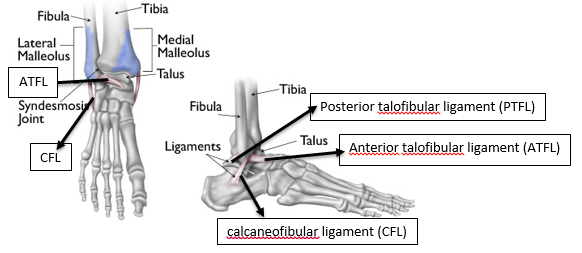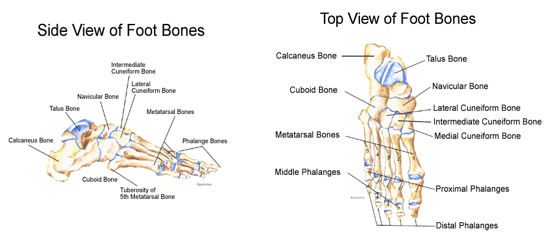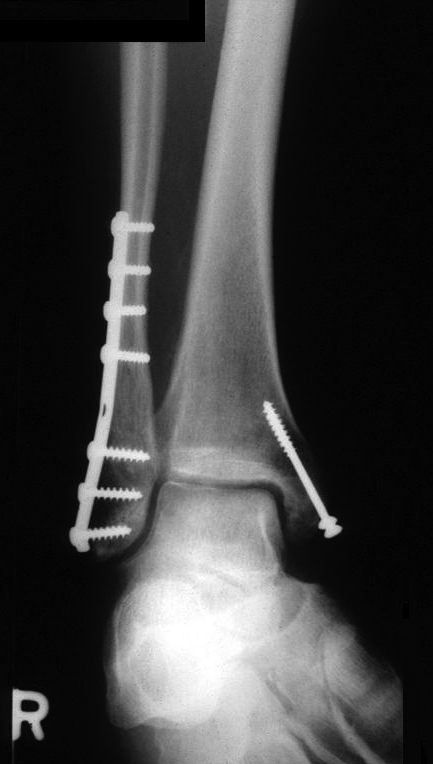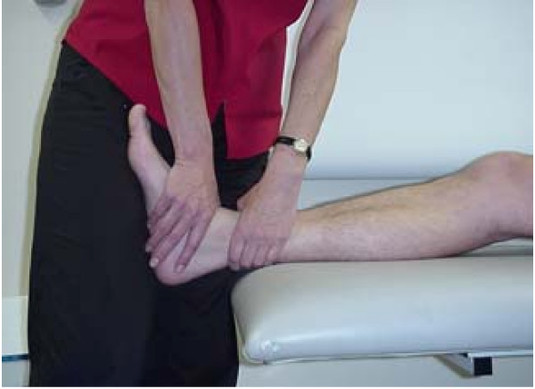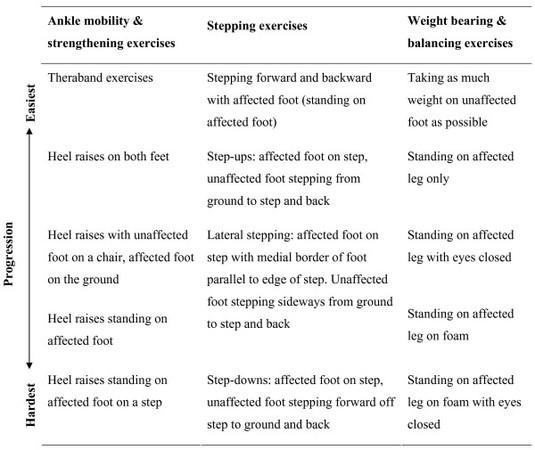Ankle and Foot Fractures: Difference between revisions
No edit summary |
No edit summary |
||
| Line 7: | Line 7: | ||
An ankle fracture is a fracture in a bone that shapes the ankle. This can be the superior articular surface of the talus, the end of the fibula (malleolus lateralis), the end of the tibia (malleolus medialis) or both (bimalleolar fracture) (Figure 1). They usually result from an external or internal rotation injury to the ankle. <br>Ankle fractures can range from the less serious avulsion injuries (small pieces of bone that are pulled off) to severe shattering-type breaks. The ankle ligaments, keeping the ankle in its normal position, could possibly be involved. These fractures are among the most common fractures in adults. (7) Ankle fractures are common musculoskeletal injuries that occur in a bimodal distribution. These fractures are common in younger men and older women, the former related to high-energy trauma and the latter to osteopenia and osteoporosis. (29) Ankle fractures are usually caused by falls, twisting injuries and sports injuries. (4) | An ankle fracture is a fracture in a bone that shapes the ankle. This can be the superior articular surface of the talus, the end of the fibula (malleolus lateralis), the end of the tibia (malleolus medialis) or both (bimalleolar fracture) (Figure 1). They usually result from an external or internal rotation injury to the ankle. <br>Ankle fractures can range from the less serious avulsion injuries (small pieces of bone that are pulled off) to severe shattering-type breaks. The ankle ligaments, keeping the ankle in its normal position, could possibly be involved. These fractures are among the most common fractures in adults. (7) Ankle fractures are common musculoskeletal injuries that occur in a bimodal distribution. These fractures are common in younger men and older women, the former related to high-energy trauma and the latter to osteopenia and osteoporosis. (29) Ankle fractures are usually caused by falls, twisting injuries and sports injuries. (4) | ||
[[Image:Figure 1-Ankle fracture.PNG]]<br> | [[Image:Figure 1-Ankle fracture.PNG]] [[Image:Figure 2- Foot fracture.PNG]]Figure 2: Proximal fifth metatarsal avulsion fracture <br> | ||
A foot fracture can occur in any part of the foot (hindfoot, midfoot and forefoot). These are different types of foot fractures : [[Calcaneal Fractures|calcaneal fractures]], [[Leg and Foot Stress Fractures|leg and foot stress fractures]], [[Metatarsal Fractures|metatarsal fractures ]](Figure 2), [[Avulsion Fractures of the Ankle|avulsion Fractures of the ankle]], [[Chopart fracture-dislocation|Chopart fracture]], [[Lisfranc Injuries|Lisfranc fracture and]] [[Pott's fracture|Pott’s fracture. ]] | A foot fracture can occur in any part of the foot (hindfoot, midfoot and forefoot). These are different types of foot fractures : [[Calcaneal Fractures|calcaneal fractures]], [[Leg and Foot Stress Fractures|leg and foot stress fractures]], [[Metatarsal Fractures|metatarsal fractures ]](Figure 2), [[Avulsion Fractures of the Ankle|avulsion Fractures of the ankle]], [[Chopart fracture-dislocation|Chopart fracture]], [[Lisfranc Injuries|Lisfranc fracture and]] [[Pott's fracture|Pott’s fracture. ]] | ||
[[Image:Figure | == Clinically Relevant Anatomy == | ||
[[Image:Figure 3-Ankle ligaments.PNG]]Figure 3: Ankle ligaments | |||
<br> | The ankle joint also known as talocrural joint is made up of three bony structures: the distal ends of the tibia (shinbone) and fibula and the talus. The tibia and fibula have specific parts that make up the ankle:<br>• Medial malleolus - inside part of the tibia<br>• Posterior malleolus - back part of the tibia<br>• Lateral malleolus – end of the fibula<br>The tibia and fibula are bound to the ankle joint by the ligamentous structures of the syndesmosis (interosseous membrane; anterior, posterior, and transverse tibiofibular ligaments (figure 3)). There are collateral ligaments that stabilize the joint against stress from the sides: laterally, the anterior talofibular ligament (ATFL), calcaneofibular ligament (CFL), and posterior talofibular ligament (PTFL), and, medially, the broad fan of the deltoid ligament and the plantar calcaneonavicular ligament, whose medial border is blended with the forepart of the deltoid ligament. (7)<br> | ||
[[Image:Figure 4- Foot bones.PNG]]Figure 4: Foot Bones | |||
The foot contains 26 bones (Figure 4). The foot is divided into three main parts: hindfoot, midfoot and forefoot.<br>• Hindfoot is composed of 2 bones, calcaneus and talus. They form the subtalar joint<br>• Midfoot is made up of 5 bones, navicular, cuboid and 3 cuneiforms (medial, intermediate and lateral). The bones are connected to the forefoot and the hindfoot by muscles and the plantar fascia (arch ligament). <br>• Forefoot is consists of 19 bones, which are 5 metatarsals, 14 phalanges. <br>The Chopart joint is the connection between the hindfoot to the midfoot involving the ‘talonavicular joint’ and the ‘calcaneocuboid joint’; the Lisfranc joint connects the forefoot to the midfoot. | |||
== Epidemiology /Etiology == | == Epidemiology /Etiology == | ||
There are different causes for an ankle fracture:<br>- A big force that works into the bone. For example a kick or a smack during sport activities or a car accident.<br>- A little piece of the bone tears off when there is pulled at a ligament. For example when you stumble. <br>- Twisting or rotating your ankle <br>- Rolled your ankle<br> | Ankle fracture is caused by low-velocity trauma such as falls, twisting injuries and sports-related injuries (4) (24), and therefore it does not only occur in the older, but also in the young and active population. | ||
There are different causes for an ankle fracture:<br>- A big force that works into the bone. For example a kick or a smack during sport activities or a car accident.<br>- A little piece of the bone tears off when there is pulled at a ligament. For example when you stumble. <br>- Twisting or rotating your ankle <br>- Rolled your ankle (4)<br> | |||
There are a number of risk factors associated with an increased risk of sustaining foot and ankle fractures including smoking, diabetes, obesity, previous falls and/or fractures, very high or low levels of physical activity, and low bone mineral density (BMD). For older individuals over an age of 50, additional risk factors include female gender, comorbidities and multiple medications. <br>Ankle fractures is more common with those having a higher body mass index and those with a higher risk of falling, while foot fractures have been associated with a lower bone mineral density (BMD). The higher level of activity in younger males, particularly in risk taking and sports activities, might explain the high rates of ankle and foot fractures in this age group. Younger female, under the age of 50, less active than males, however they have a higher tendency to fall, later in life which coincides with postmenopausal bone loss, resulting in an increase in fracture risk. (27)<br>Inversion injuries may also lead to ankle fractures. (10) | |||
== Characteristics/Clinical Presentation == | == Characteristics/Clinical Presentation == | ||
- Difficulties or even inability to walk or load the ankle. (it is possible to walk with less severe breaks, so never rely on walking as a test of whether a bone has been fractured.<br>- Pain <br>- Swelling, along the length of the leg or more localized<br>- Blisters (over the fracture site).<br>- Bruising (soon after the injury).<br>- Difference in appearance.<br>When an ankle has been broken, there is not only structural damage to the skeletal structure, but also to the ligament tissue (deltoid ligament and the anterior and posterior tibiofibular ligaments) and possibly nervous and musculoskeletal tissue around the ankle complex.. This can result in impaired balance capacity, reduced joint position sense, slowed nerve conduction, velocity, impaired cutaneous sensation and decreased dorsal extension range of motion<ref name="Nilsson et al">Nilsson G, Nyberg P, Ekdahl CH, Eneroth M. Performance after surgical treatment of patients with ankle fractures – 14-month follow-up. Physiotherapy Research International 2003, 8(2) 69-82</ref><br> | - Difficulties or even inability to walk or load the ankle. (it is possible to walk with less severe breaks, so never rely on walking as a test of whether a bone has been fractured.<br>- Pain <br>- Swelling, along the length of the leg or more localized<br>- Blisters (over the fracture site).<br>- Bruising (soon after the injury).<br>- Difference in appearance.<br>When an ankle has been broken, there is not only structural damage to the skeletal structure, but also to the ligament tissue (deltoid ligament and the anterior and posterior tibiofibular ligaments) and possibly nervous and musculoskeletal tissue around the ankle complex.. This can result in impaired balance capacity, reduced joint position sense, slowed nerve conduction, velocity, impaired cutaneous sensation and decreased dorsal extension range of motion<ref name="Nilsson et al">Nilsson G, Nyberg P, Ekdahl CH, Eneroth M. Performance after surgical treatment of patients with ankle fractures – 14-month follow-up. Physiotherapy Research International 2003, 8(2) 69-82</ref><br> | ||
The most important characteristics of fractures ankle or foot are:<br>• Pain at rest as well during load and on palpation<br>• Haemorrhage <br>• Abnormal figure compared with healthy side <br>• Swelling on the fracture<br>• Insensibility at the foot or ankle<br>• Inability to walk or to lean<br>By a fracture at the ankle, there isn’t only damage at the bones. There is also damage to the ligaments of the ankle. (Lig. Tibiofibulare anterior and posterior, lig. Talofibulare anterior and posterior, lig. Calcaneofibulare, lig. Deltoideum).<br>The first ankle fracture classification, attributed to Percival Pott, described three types of ankle fractures based on the number of malleoli involved: unimalleolar, bimalleolar, and trimalleolar. Despite its ease of use and reproducibility, the classification gives not enough information about the mechanics of the fracture, as it failed to differentiate stable from unstable injuries. (29)<br> | |||
At present an ankle fractures can also be classified according to either the AO Foundation (Association for the Study of Internal Fixation)/ Orthopaedic Trauma Association (OTA), the Danis-Weber classification or Lauge-Hansen classification. | |||
The Lauge-Hansen classification is based on a rotational mechanism of injury: 4 categories and 13 subgroups of ankle fractures were created based on his study.<br>'''Supination external rotation (SER)''' <br>1. Injury of the anterior inferior tibiofibular ligament<br>2. Oblique/spiral fracture of the distal fibula<br>3. Injury of the posterior inferior tibiofibular ligament or avulsion of the posterior malleolus<br>4. Medial malleolus fracture or injury to the deltoid ligament<br>'''Supination adduction (SA)''' <br>1. Transverse fracture of the distal fibula<br>2. Vertical fracture of the medial malleolus<br>'''Pronation external rotation (PER) '''<br>1. Medial malleolus fracture or injury to the deltoid ligament<br>2. Injury of the anterior inferior tibiofibular ligament<br>3. Oblique/spiral fracture of the fibula proximal to the tibial plafond<br>4. Injury of the posterior inferior tibiofibular ligament or avulsion of the posterior malleolus<br>'''Pronation abduction (PA) '''<br>1. Medial malleolus fracture or injury to the deltoid ligament<br>2. Injury of the anterior inferior tibiofibular ligament<br>3. Transverse or comminuted fracture of the fibula proximal to the tibial plafond<br><br> The Danis-Weber classification is based on radiographic criteria. It took into consideration the position of the distal fibular fracture in relation to the syndesmosis of the ankle joint. Three categories were created:<br>• Type A fracture: below the level of the tibial plafond (syndesmosis) and may be associated with oblique or vertical medial malleolar fractures <br>• Type B fractures: at the level of the tibial plafond (syndesmosis) and extend proximally in an oblique fashion<br>• Type C fractures: proximal to the level of the tibial plafond and often have an associated syndesmotic injury. It can be associated with medial malleolus fractures or injury to the deltoid ligament. (7) (29)<br> | |||
The AO and Lauge-Hansen classification systems are widely used in the clinical diagnosis of ankle injuries. The AO classification system is simple to understand, and it emphasizes the coordinating role of the fibula and syndesmosis of the ankle joint. The Lauge-Hansen classification system emphasizes the different stages of pathological damage in addition to the fracture pattern, and it insists on the understanding of damage to the ankle ligament system. It can provide an extensive assessment of ankle injuries. <br>Compared to Lauge-Hansen classification, AO classification system is more reliable and reproducible and thus has more value in clinical practice, than the Lauge-Hansen classification system. Despite this, the Lauge-Hansen classification system stands as the basis for understanding the mechanics of ankle fractures (10) | |||
AO classification/OTA system classifies all long bone fractures with a systematic approach, based on location, topography, and extent of bony lesion. It is based on radiographic criteria and incorporates the mechanism of injury. The fractures are classified as infrasyndesmotic, transsyndesmotic and suprasyndesmotic with further subcategories based on the presence or absence of medial or posterior malleolar injuries.<br> | |||
These classifications are parallel to each other. (Table 1)<br>Table 1: Comparison of the Danis-Weber, Lauge-Hansen, and AO/OTA classification systems | |||
{| width="200" border="1" cellspacing="1" cellpadding="1" | |||
|- | |||
| | |||
Fibular fracture location | |||
<br> | |||
| Danis-Weber classification <br> | |||
<br> | |||
| Lauge-Hansen classification<br>SAD I, II | |||
<br> | |||
| | |||
AO/OTA classification of tibial malleolar fractures<br> | |||
<br> | |||
|- | |||
| Infrasyndesmotic | |||
| Type A | |||
| SAD I, II | |||
| 44-A1 (isolated lateral)<br>44-A2 (lateral and medial)<br>44-A3 (lateral, medial, and posterior) | |||
|- | |||
| Transsyndesmotic | |||
| Type B | |||
| SER I, II, III, IV | |||
| 44-B1 (isolated lateral)<br>44-B2 (lateral and medial)<br>44-B3 (lateral, medial, and Volkmann’s fracture) | |||
|- | |||
| Suprasyndesmotic | |||
| Type C | |||
| | |||
PER I, II, III, IV | |||
PA I, II, III | |||
| 44-C1 (simple diaphyseal)<br>44-C2 (multifragmentary)<br>44-C3 (proximal | |||
|} | |||
OTA = Orthopaedic Trauma Association; SAD = supination adduction; SER = supination external rotation; PER = pronation external rotation; PA = pronation abduction. (29) | |||
== Differential Diagnosis == | == Differential Diagnosis == | ||
There are differential diagnosis of foot and ankle injuries which are: (1) stress fractures of the great toe sesamoids, the shaft of the fifth metatarsal, and the tarsal navicular bone; (2) transchondral talar-dome fractures; (3) fractures of the os trigonum; and (4) dislocating peroneal tendons. Diagnosis of these injuries is challenging due to the fact that the initial X-rays often are normal, and special clinical tests and additional studies are required. (28)<br>• Rheumatoid Arthritis<br>• Gout and Pseudogout<br>• Ankle Dislocation in Emergency Medicine<br>• [[Ankle Impingement|Ankle Impingement]]<br>• [[Compartment Syndrome of the Foot|Compartment Syndrome of the foot]]<br>• Deep Venous Thrombosis and Thrombophlebitis<br>• [[Peroneal Tendonitis|Peroneal Tendonitis]]<br>• Ankle Injury, Soft Tissue: [[Sinus Tarsi Syndrome|Sinus Tarsi Syndrome due]] repetitive strain or ligamentous injuries like [[Ankle Sprain|ankle sprains]]. <br>The clinical presentation of some subtle fractures of the ankle can be similar to that of ankle sprains. This similarity makes that ankle fracture is often mistaken as ankle sprain. These injuries are quite different and need an accurate and early diagnosis. (12)<br> | |||
== Diagnostic Procedures == | == Diagnostic Procedures == | ||
To evaluate the ankle in the acute fase, we use the ‘Ottawa ankle rules’. [[Ottawa Ankle Rules|Ottawa_Ankle_Rules]] | To evaluate the ankle in the acute fase, we use the ‘Ottawa ankle rules’. [[Ottawa Ankle Rules|Ottawa_Ankle_Rules]] | ||
Ankle fractures are initially evaluated by physical examination and then by x-ray. (7)<br>To reduce the use of x-rays, an intrasound device can be used to detect malleolar fractures even though it cannot be relied upon alone due to an 85% sensitivity and 52% sensitivity. (8)<br>Ultrasound had good sensitivity and specificity for diagnosing fifth metatarsal, lateral and medial malleolus fractures in patients with foot and/or ankle sprains. However, sensitivity and specificity of ultrasound for navicular fractures were low. (9)<br> | |||
== Examination == | == Examination == | ||
| Line 83: | Line 144: | ||
== References == | == References == | ||
<references /><br> | <references /><br> | ||
[[Category:Injury]] [[Category:Ankle]] [[Category:Bones]] [[Category:Musculoskeletal/Orthopaedics|Orthopaedics]] | [[Category:Injury]] [[Category:Ankle]] [[Category:Bones]] [[Category:Musculoskeletal/Orthopaedics|Orthopaedics]] | ||
Revision as of 16:46, 30 May 2016
Search Strategy[edit | edit source]
We searched scientific articles and information by using PubMed, web of knowledge, Google Scholar, PEDro and Medline. We used keywords such as ankle and foot fractures, Lis franc fracture, malleolar fracture, calcaneus fracture, surgical or operative treatment and nonsurgical or conservative treatment, ankle sprain and ankle fracture. We also used some inclusion criteria as foot and ankle fractures and exclusion criteria as ankle sprain or ankle instability to find relevant articles in French or English.
Definition/Description[edit | edit source]
An ankle fracture is a fracture in a bone that shapes the ankle. This can be the superior articular surface of the talus, the end of the fibula (malleolus lateralis), the end of the tibia (malleolus medialis) or both (bimalleolar fracture) (Figure 1). They usually result from an external or internal rotation injury to the ankle.
Ankle fractures can range from the less serious avulsion injuries (small pieces of bone that are pulled off) to severe shattering-type breaks. The ankle ligaments, keeping the ankle in its normal position, could possibly be involved. These fractures are among the most common fractures in adults. (7) Ankle fractures are common musculoskeletal injuries that occur in a bimodal distribution. These fractures are common in younger men and older women, the former related to high-energy trauma and the latter to osteopenia and osteoporosis. (29) Ankle fractures are usually caused by falls, twisting injuries and sports injuries. (4)
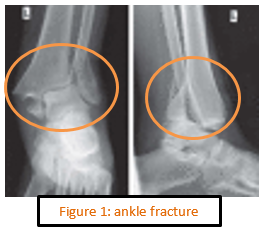
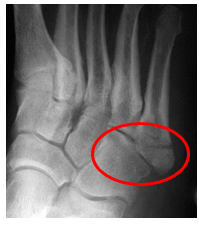
A foot fracture can occur in any part of the foot (hindfoot, midfoot and forefoot). These are different types of foot fractures : calcaneal fractures, leg and foot stress fractures, metatarsal fractures (Figure 2), avulsion Fractures of the ankle, Chopart fracture, Lisfranc fracture and Pott’s fracture.
Clinically Relevant Anatomy[edit | edit source]
The ankle joint also known as talocrural joint is made up of three bony structures: the distal ends of the tibia (shinbone) and fibula and the talus. The tibia and fibula have specific parts that make up the ankle:
• Medial malleolus - inside part of the tibia
• Posterior malleolus - back part of the tibia
• Lateral malleolus – end of the fibula
The tibia and fibula are bound to the ankle joint by the ligamentous structures of the syndesmosis (interosseous membrane; anterior, posterior, and transverse tibiofibular ligaments (figure 3)). There are collateral ligaments that stabilize the joint against stress from the sides: laterally, the anterior talofibular ligament (ATFL), calcaneofibular ligament (CFL), and posterior talofibular ligament (PTFL), and, medially, the broad fan of the deltoid ligament and the plantar calcaneonavicular ligament, whose medial border is blended with the forepart of the deltoid ligament. (7)
The foot contains 26 bones (Figure 4). The foot is divided into three main parts: hindfoot, midfoot and forefoot.
• Hindfoot is composed of 2 bones, calcaneus and talus. They form the subtalar joint
• Midfoot is made up of 5 bones, navicular, cuboid and 3 cuneiforms (medial, intermediate and lateral). The bones are connected to the forefoot and the hindfoot by muscles and the plantar fascia (arch ligament).
• Forefoot is consists of 19 bones, which are 5 metatarsals, 14 phalanges.
The Chopart joint is the connection between the hindfoot to the midfoot involving the ‘talonavicular joint’ and the ‘calcaneocuboid joint’; the Lisfranc joint connects the forefoot to the midfoot.
Epidemiology /Etiology[edit | edit source]
Ankle fracture is caused by low-velocity trauma such as falls, twisting injuries and sports-related injuries (4) (24), and therefore it does not only occur in the older, but also in the young and active population.
There are different causes for an ankle fracture:
- A big force that works into the bone. For example a kick or a smack during sport activities or a car accident.
- A little piece of the bone tears off when there is pulled at a ligament. For example when you stumble.
- Twisting or rotating your ankle
- Rolled your ankle (4)
There are a number of risk factors associated with an increased risk of sustaining foot and ankle fractures including smoking, diabetes, obesity, previous falls and/or fractures, very high or low levels of physical activity, and low bone mineral density (BMD). For older individuals over an age of 50, additional risk factors include female gender, comorbidities and multiple medications.
Ankle fractures is more common with those having a higher body mass index and those with a higher risk of falling, while foot fractures have been associated with a lower bone mineral density (BMD). The higher level of activity in younger males, particularly in risk taking and sports activities, might explain the high rates of ankle and foot fractures in this age group. Younger female, under the age of 50, less active than males, however they have a higher tendency to fall, later in life which coincides with postmenopausal bone loss, resulting in an increase in fracture risk. (27)
Inversion injuries may also lead to ankle fractures. (10)
Characteristics/Clinical Presentation[edit | edit source]
- Difficulties or even inability to walk or load the ankle. (it is possible to walk with less severe breaks, so never rely on walking as a test of whether a bone has been fractured.
- Pain
- Swelling, along the length of the leg or more localized
- Blisters (over the fracture site).
- Bruising (soon after the injury).
- Difference in appearance.
When an ankle has been broken, there is not only structural damage to the skeletal structure, but also to the ligament tissue (deltoid ligament and the anterior and posterior tibiofibular ligaments) and possibly nervous and musculoskeletal tissue around the ankle complex.. This can result in impaired balance capacity, reduced joint position sense, slowed nerve conduction, velocity, impaired cutaneous sensation and decreased dorsal extension range of motion[1]
The most important characteristics of fractures ankle or foot are:
• Pain at rest as well during load and on palpation
• Haemorrhage
• Abnormal figure compared with healthy side
• Swelling on the fracture
• Insensibility at the foot or ankle
• Inability to walk or to lean
By a fracture at the ankle, there isn’t only damage at the bones. There is also damage to the ligaments of the ankle. (Lig. Tibiofibulare anterior and posterior, lig. Talofibulare anterior and posterior, lig. Calcaneofibulare, lig. Deltoideum).
The first ankle fracture classification, attributed to Percival Pott, described three types of ankle fractures based on the number of malleoli involved: unimalleolar, bimalleolar, and trimalleolar. Despite its ease of use and reproducibility, the classification gives not enough information about the mechanics of the fracture, as it failed to differentiate stable from unstable injuries. (29)
At present an ankle fractures can also be classified according to either the AO Foundation (Association for the Study of Internal Fixation)/ Orthopaedic Trauma Association (OTA), the Danis-Weber classification or Lauge-Hansen classification.
The Lauge-Hansen classification is based on a rotational mechanism of injury: 4 categories and 13 subgroups of ankle fractures were created based on his study.
Supination external rotation (SER)
1. Injury of the anterior inferior tibiofibular ligament
2. Oblique/spiral fracture of the distal fibula
3. Injury of the posterior inferior tibiofibular ligament or avulsion of the posterior malleolus
4. Medial malleolus fracture or injury to the deltoid ligament
Supination adduction (SA)
1. Transverse fracture of the distal fibula
2. Vertical fracture of the medial malleolus
Pronation external rotation (PER)
1. Medial malleolus fracture or injury to the deltoid ligament
2. Injury of the anterior inferior tibiofibular ligament
3. Oblique/spiral fracture of the fibula proximal to the tibial plafond
4. Injury of the posterior inferior tibiofibular ligament or avulsion of the posterior malleolus
Pronation abduction (PA)
1. Medial malleolus fracture or injury to the deltoid ligament
2. Injury of the anterior inferior tibiofibular ligament
3. Transverse or comminuted fracture of the fibula proximal to the tibial plafond
The Danis-Weber classification is based on radiographic criteria. It took into consideration the position of the distal fibular fracture in relation to the syndesmosis of the ankle joint. Three categories were created:
• Type A fracture: below the level of the tibial plafond (syndesmosis) and may be associated with oblique or vertical medial malleolar fractures
• Type B fractures: at the level of the tibial plafond (syndesmosis) and extend proximally in an oblique fashion
• Type C fractures: proximal to the level of the tibial plafond and often have an associated syndesmotic injury. It can be associated with medial malleolus fractures or injury to the deltoid ligament. (7) (29)
The AO and Lauge-Hansen classification systems are widely used in the clinical diagnosis of ankle injuries. The AO classification system is simple to understand, and it emphasizes the coordinating role of the fibula and syndesmosis of the ankle joint. The Lauge-Hansen classification system emphasizes the different stages of pathological damage in addition to the fracture pattern, and it insists on the understanding of damage to the ankle ligament system. It can provide an extensive assessment of ankle injuries.
Compared to Lauge-Hansen classification, AO classification system is more reliable and reproducible and thus has more value in clinical practice, than the Lauge-Hansen classification system. Despite this, the Lauge-Hansen classification system stands as the basis for understanding the mechanics of ankle fractures (10)
AO classification/OTA system classifies all long bone fractures with a systematic approach, based on location, topography, and extent of bony lesion. It is based on radiographic criteria and incorporates the mechanism of injury. The fractures are classified as infrasyndesmotic, transsyndesmotic and suprasyndesmotic with further subcategories based on the presence or absence of medial or posterior malleolar injuries.
These classifications are parallel to each other. (Table 1)
Table 1: Comparison of the Danis-Weber, Lauge-Hansen, and AO/OTA classification systems
|
Fibular fracture location
|
Danis-Weber classification
|
Lauge-Hansen classification SAD I, II
|
AO/OTA classification of tibial malleolar fractures
|
| Infrasyndesmotic | Type A | SAD I, II | 44-A1 (isolated lateral) 44-A2 (lateral and medial) 44-A3 (lateral, medial, and posterior) |
| Transsyndesmotic | Type B | SER I, II, III, IV | 44-B1 (isolated lateral) 44-B2 (lateral and medial) 44-B3 (lateral, medial, and Volkmann’s fracture) |
| Suprasyndesmotic | Type C |
PER I, II, III, IV PA I, II, III |
44-C1 (simple diaphyseal) 44-C2 (multifragmentary) 44-C3 (proximal |
OTA = Orthopaedic Trauma Association; SAD = supination adduction; SER = supination external rotation; PER = pronation external rotation; PA = pronation abduction. (29)
Differential Diagnosis[edit | edit source]
There are differential diagnosis of foot and ankle injuries which are: (1) stress fractures of the great toe sesamoids, the shaft of the fifth metatarsal, and the tarsal navicular bone; (2) transchondral talar-dome fractures; (3) fractures of the os trigonum; and (4) dislocating peroneal tendons. Diagnosis of these injuries is challenging due to the fact that the initial X-rays often are normal, and special clinical tests and additional studies are required. (28)
• Rheumatoid Arthritis
• Gout and Pseudogout
• Ankle Dislocation in Emergency Medicine
• Ankle Impingement
• Compartment Syndrome of the foot
• Deep Venous Thrombosis and Thrombophlebitis
• Peroneal Tendonitis
• Ankle Injury, Soft Tissue: Sinus Tarsi Syndrome due repetitive strain or ligamentous injuries like ankle sprains.
The clinical presentation of some subtle fractures of the ankle can be similar to that of ankle sprains. This similarity makes that ankle fracture is often mistaken as ankle sprain. These injuries are quite different and need an accurate and early diagnosis. (12)
Diagnostic Procedures[edit | edit source]
To evaluate the ankle in the acute fase, we use the ‘Ottawa ankle rules’. Ottawa_Ankle_Rules
Ankle fractures are initially evaluated by physical examination and then by x-ray. (7)
To reduce the use of x-rays, an intrasound device can be used to detect malleolar fractures even though it cannot be relied upon alone due to an 85% sensitivity and 52% sensitivity. (8)
Ultrasound had good sensitivity and specificity for diagnosing fifth metatarsal, lateral and medial malleolus fractures in patients with foot and/or ankle sprains. However, sensitivity and specificity of ultrasound for navicular fractures were low. (9)
Examination[edit | edit source]
add text here related to physical examination and assessment
Outcomes Measures[edit | edit source]
Medical Management
[edit | edit source]
Most patients with a malleolus fracture require 6 weeks of immobilization. Patients with an initially non-displaced fracture or who were treated surgically will generally require 4 weeks of non-weight bearing in a short-leg cast or removable walking boot, followed by 2 weeks in a walking cast or boot. The removable boot will allow for earlier range-of-motion exercises.
Surgery is needed for many types of ankle fractures. While not always necessary, surgery for ankle fractures is not uncommon. The need for surgery depends on the appearance of the ankle joint on X-ray and the type of ankle fracture.
Adequate reduction with congruency of the joint has been reported as one of the most important indications of a good end result. Inadequate reduction may lead to osteoarthritis.
Physical Therapy Management
[edit | edit source]
After 6 weeks of immobilization, the ankle can be fully loaded. There is no standardized rehabilitation program after cast removal. Each program is individually[1]
Physiotherapists are often involved in the rehabilitation, which starts quickly (1 week) after the period of immobilization. Most people experience pain, swelling, stiffness, muscle atrophy and decreased muscle torque[2], impaired ankle mobility, impaired balance capacity and increased ankle circumference[1] at the ankle after cast removal. Consequently, patients complain of limitation in activities involving the lower limb, such as stair climbing, walking and reduced participation in work and recreation. It has been found that patients with unimalleolar fractures report less activity limitation than those with bimalleolar or trimalleolar fractures[3]
Passive joint mobilization is commonly used to work on the problems of pain and joint stiffness, in order to allow an earlier return to activities. For this technique, the physiotherapist manually glides the articular surfaces of a joint to produce oscillatory movements. It has been proven that manual therapy, such as joint mobilization, produces analgesic effects. It also increases elasticity of joint structures through interactions at the local, central nervous system and psychological levels[4]
There is evidence that, after a surgical treatment for an ankle fracture, a training program, started within one week after cast removal and continued for 12 weeks (with 2 appointments per week), shows superior results compared to usual care, regarding patient scored function and muscle strength in the plantar flexors and dorsiflexors of patients under the age of 40. The patients had to do home exercises daily, prescribed by the physiotherapist, appropriate to the functional status at the time. Functional goals are loaded ankle dorsiflexion, plantairflexion, on-leg-stance, rising on toes, rising on heels, normalized walking pattern when walking on even ground, on stairs and at comfortable speed[5]
When the cast is removed, many patients have a plantarflexion contracture (http://www.physio-pedia.com/index.php5?title=Plantarflexion_contracture). This contracture is not caused directly by fracture but develops as an adaptive response to immobilization. The addition of a program of passive stretches has no benefit over exercise alone for the treatment of plantarflexion contracture after cast immobilization[6]
Key Research[edit | edit source]
Resources
[edit | edit source]
http://orthopedics.about.com/od/footanklefractures/Information_About_Foot_Ankle_Fractures.htm
http://www.foothealthfacts.org/footankleinfo/ankle-fracture.htm
http://www.invaliditeit.be/enkelbreuk.html
http://www.associatie-orthopedie-lier.be/Generic/servlet/Main.html?p_pageid=37245
http://www.dokterdokter.nl/medisch/folder/view/id/1582/gebroken-enkel
Clinical Bottom Line[edit | edit source]
The evaluation of ankle injuries is a common challenge for family physicians. Diagnosis is made by using knowledge of the anatomy and function of the ankle joint to aid in taking an adequate history and performing an appropriate physical examination. The patient should be questioned about the mechanism of injury, previous injury, disability, treatment and pain. The ankle should be evaluated for ecchymosis, swelling, areas of tenderness and laxity. These measures help to determine what, if any, additional diagnostic procedures may be needed. Most ankle sprains are lateral, affecting the anterior talofibular, calcaneofibular and posterior talofibular ligaments. Other injuries include medial ankle sprains affecting the deltoid ligament, trauma to the Achilles and peroneal tendons, tarsal tunnel syndrome, fractures, syndesmotic sprains, synovial impingement and chronic instability. Criteria for radiographic evaluation include inability to bear weight initially or when examined, and tenderness over the medial or lateral malleolus. Accurate diagnosis is critical for appropriate treatment and minimizing functional disability. (26)
Suspected injury is based on the details from the medical history, general physical examination and orthopaedic physical examination. It is important to establish the relationship between the start of painful symptoms and physical activity, generally performed repetitively, abrupt changes in the amount of training and the presence of risk factors.
Initially, pain emerges at the end of the exercises and intensifies over some weeks; it may occur during the entire activity, and be constant during walking. Pain worsens and transforms training into suffering. Training becomes increasingly painful and difficult to continue. Even after some days of rest, returning to activities too early leads to recurrence of the pain. (30)
Recent Related Research (from Pubmed)[edit | edit source]
see tutorial on Adding PubMed Feed
Extension:RSS -- Error: Not a valid URL: Feed goes here!!|charset=UTF-8|short|max=10
References [edit | edit source]
- ↑ 1.0 1.1 1.2 Nilsson G, Nyberg P, Ekdahl CH, Eneroth M. Performance after surgical treatment of patients with ankle fractures – 14-month follow-up. Physiotherapy Research International 2003, 8(2) 69-82
- ↑ Nilsson G, Jonsson K, Ekdahl CH, Eneroth M. Outcome and quality of life after surgically treated ankle fractures in patients 65 years or older. BMC Musculoskeletal Disorders 2007;8:127
- ↑ Lin CC, Moseley AM, Herbert RD, Refshauge KM. Pain and dorsiflexion range of motion predict short-and medium-term activity limitation in people receiving physiotherapy intervention after ankle fracture: an observational study. Australian Journal of Physiotherapy 2009, 55;31-37
- ↑ Lin C CH, Moseley AM, Refshauge KM, Haas M, Herbert RD. Effectiveness of joint mobilisation after cast immobilisation for ankle fracture: a protocol for a randomised controlled trial. BMC Musculoskeletal Disorders 2006;7:46
- ↑ Nilsson G, Jonsson K, Ekdahl CH, Eneroth M. Effects of a training program after surgically treated ankle fracture : a prospective randomised controlled trial. BMC Musculoskeletal Disorders 2009;10:118
- ↑ Moseley AM, Herbert RD, Nightingale EJ, Taylor DA, Evans TM, Robertson GJ, Gupta SK, Penn J. Passive stretching does not enhance outcomes in patients with plantarflexion contracture after cast immobilization for ankle fracture : a randomized controlled trial. Arch Phys Med Rehabil 2005;86 :1118-26
